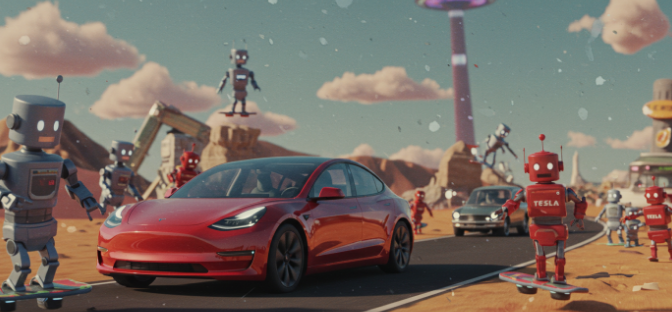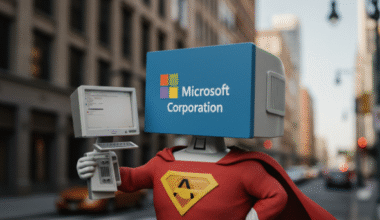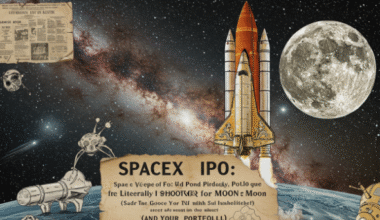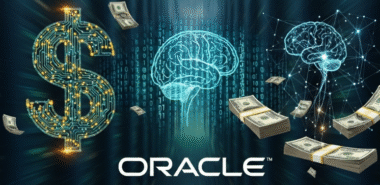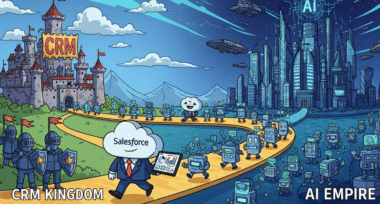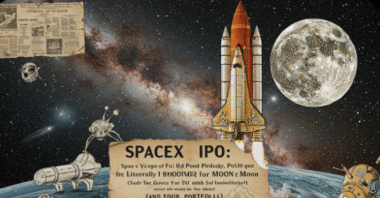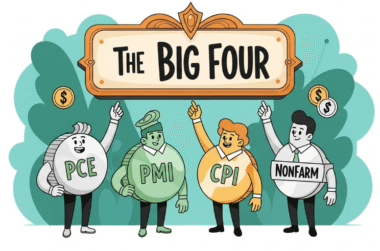Stock Symbol: TSLA | Current Price: ~$250 (September 2025) | Target Price: $350+ | Timeframe: 12-18 months
NOT FINANCIAL ADVISE
Tesla has officially graduated from “that electric car company” to “that AI company that also happens to make cars, robots, and energy storage systems while occasionally launching things into space.” With Q2 2025 revenue hitting $22.5 billion and the commercial rollout of robotaxi service in Austin, Tesla is proving that Elon Musk’s seemingly impossible promises might actually be… well, still impossible, but getting closer to reality. The company delivered 384,000 vehicles while simultaneously working on producing 100,000 humanoid robots per month within 16 months, because apparently making cars wasn’t complicated enough. It’s like watching someone juggle flaming torches while riding a unicycle on a tightrope, except the torches are autonomous vehicles and the tightrope is the future of transportation.
The Robotaxi Reality: From Concept Car to Cash Cow

Tesla’s robotaxi service has officially launched commercial operations in Austin, marking the transition from “Elon said it would happen” to “it’s actually happening.” The company is targeting to reach half the US population with robotaxi service by year-end, which is either incredibly ambitious or incredibly Elon, depending on your perspective.
Musk announced plans to produce 2 million Cybercabs annually and launch driverless ride-hailing services in Tesla vehicles as early as 2025 in Texas and likely California. The company has developed a ride-hailing app that some employees in California have been testing, proving that Tesla can build software that doesn’t require a steering wheel, which is more progress than most people expected.
The robotaxi business represents Tesla’s evolution from hardware manufacturer to service provider, creating recurring revenue streams that don’t depend on convincing people to buy $50,000+ vehicles. It’s like evolving from selling CD players to running Spotify, except instead of music, it’s transportation, and instead of monthly subscriptions, it’s per-ride revenue that compounds as the fleet grows.
Financial Performance: The Roller Coaster Continues
Tesla’s Q2 2025 results tell the story of a company in transition, with total revenue of $22.5 billion and earnings of $0.33 per share (non-GAAP $0.40). Automotive revenue increased 19% sequentially to $16.7 billion, while deliveries improved 14% year-over-year, proving that people still want to buy Tesla cars even when the CEO is promising to replace them with robots.
The energy storage business achieved its highest gross profit ever while deploying 9.6 GWh of energy storage systems, because apparently Tesla decided that just revolutionizing transportation wasn’t enough – they also needed to fix the electrical grid. Sequential cost increases of $300 million due to tariffs created headwinds, but Tesla’s automotive gross margin improvements suggest the company is learning to navigate political reality while maintaining profitability.
Regulatory credit revenue declined from $890 million in Q2 2024 to $439 million in Q2 2025, which sounds concerning until you realize Tesla is transitioning from selling permission to pollute to selling actual autonomous transportation services. It’s like a drug dealer going legitimate and opening a pharmacy – less immediate cash, but infinitely more scalable business model.
Full Self-Driving: The $10,000 Bet That Might Actually Pay Off

Tesla’s FSD (Full Self-Driving) adoption rates continue increasing, with the company planning customer build releases in Q3 2025 and FSD Unsupervised launching in select cities. After years of “next quarter” promises, FSD is finally approaching the “actually works most of the time” threshold, which in the autonomous vehicle world counts as a major breakthrough.
The potential for FSD price increases reflects growing confidence in the technology’s capability and market acceptance. When your software can potentially generate thousands of dollars per month in robotaxi revenue, charging $10,000+ for the capability starts looking like a bargain rather than highway robbery.
Tesla’s approach to FSD development emphasizes real-world data collection from millions of vehicles, creating competitive advantages that traditional automakers can’t easily replicate. While competitors build test fleets of hundreds of vehicles, Tesla collects autonomous driving data from over 5 million vehicles worldwide, turning every Tesla owner into an unpaid AI trainer.
The Robot Revolution: Optimus Prime Time
Tesla’s announcement of plans to produce 100,000 humanoid robots per month within 16 months represents either the most ambitious manufacturing target in history or Elon Musk’s most optimistic timeline estimate yet. The Optimus robot project transforms Tesla from automotive company to general-purpose AI robotics manufacturer, targeting applications across manufacturing, logistics, and service industries.
The robotics opportunity dwarfs the automotive market, with potential applications in every industry that currently relies on human labor. If Tesla can successfully mass-produce capable humanoid robots, the addressable market expands from the millions of people who buy cars to the billions of jobs that robots could potentially perform.
The integration of Tesla’s AI development, manufacturing expertise, and energy systems creates a comprehensive robotics platform that leverages all of the company’s core competencies. It’s like Tesla accidentally built all the components necessary for the robot revolution while trying to make better cars, which is peak accidental genius.
Investment Reality Check: Promises vs. Performance
Tesla’s biggest risk remains execution against increasingly ambitious timelines and targets. The company’s history of missing production deadlines while eventually delivering revolutionary products creates both skepticism and anticipation among investors. Betting on Tesla requires faith that eventually the reality will catch up to the promises, even if it takes longer than expected.
Competition in electric vehicles continues intensifying, with traditional automakers and new entrants launching compelling alternatives. Tesla’s response strategy emphasizes technological differentiation through FSD, robotaxi services, and integrated energy solutions rather than competing solely on vehicle specifications and pricing.
Regulatory approval for robotaxi services across multiple jurisdictions represents a significant execution risk, as government agencies move considerably slower than Elon Musk’s timelines. The company’s success depends on navigating complex regulatory environments while maintaining technological leadership and operational execution.
The Energy Wild Card: Batteries and Grid Storage
Tesla’s energy business achieved record deployments and highest gross profit margins, demonstrating that the company’s battery expertise creates value beyond automotive applications. The integration of vehicle manufacturing, energy storage, and autonomous services creates synergies that competitors struggle to replicate.
The global transition to renewable energy creates massive demand for grid-scale energy storage systems, positioning Tesla’s energy business for sustained growth independent of automotive market conditions. It’s like having a successful side business that happens to be essential for the future of civilization, which is a pretty good hedge against automotive industry volatility.
Price Target: Betting on the Future
Based on Tesla’s robotaxi commercialization, FSD progress, and expanding addressable markets through robotics and energy storage, the company presents a compelling if volatile investment opportunity with a 12-18 month price target of $350+ per share. This reflects both multiple expansion as markets recognize the transformation and fundamental growth from new revenue streams.
Key catalysts include robotaxi service expansion beyond Austin, FSD Unsupervised launch in additional cities, Optimus robot production milestones, and continued energy business growth. Tesla has successfully evolved from electric vehicle manufacturer to comprehensive AI and robotics company, creating multiple pathways to exponential value creation.
For investors seeking exposure to the autonomous vehicle revolution, AI robotics, and sustainable energy transition through a company with proven ability to turn science fiction into profitable reality, Tesla represents the ultimate high-risk, high-reward technology bet. They’ve transformed from making cars that don’t need gas to making cars that don’t need drivers, and apparently that’s just the warm-up act.
Disclaimer: This analysis contains references to robot revolutions and should not be considered personalized investment advice. Past performance does not guarantee future results, though Tesla’s track record suggests they’re remarkably good at making impossible things seem inevitable. Consult with a qualified financial advisor who hopefully understands both artificial intelligence and Elon Musk’s relationship with timelines.
Last Updated: September 2025
Next Review: December 2025
